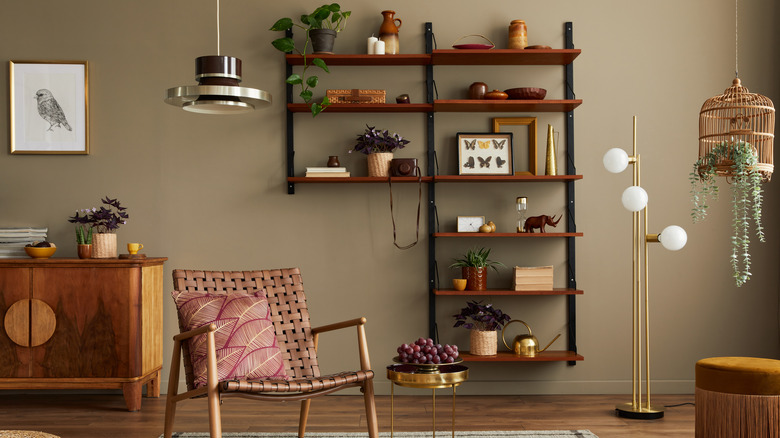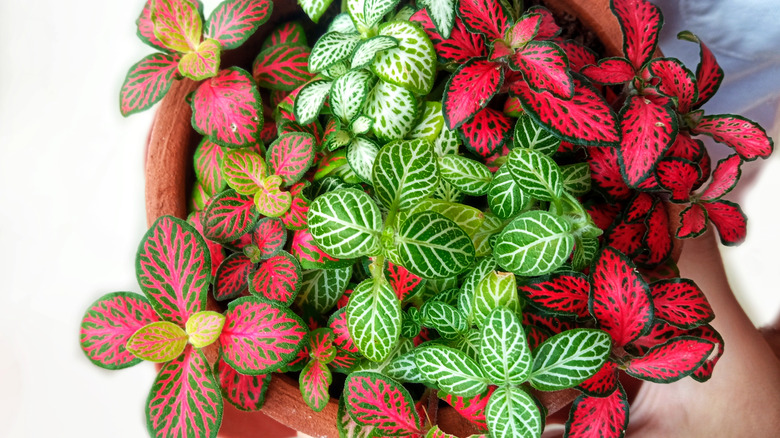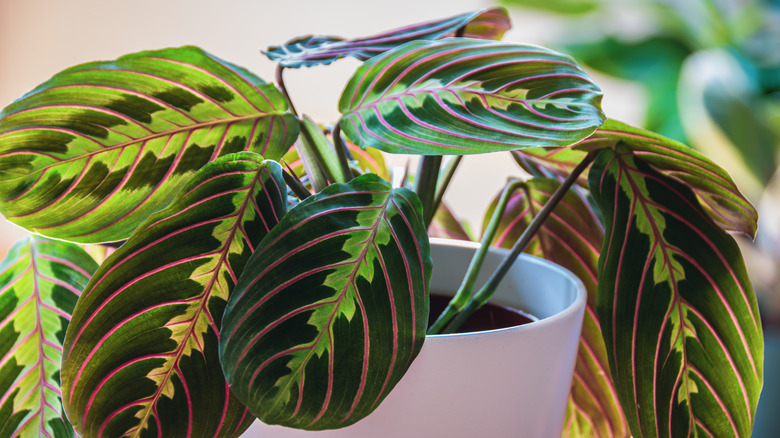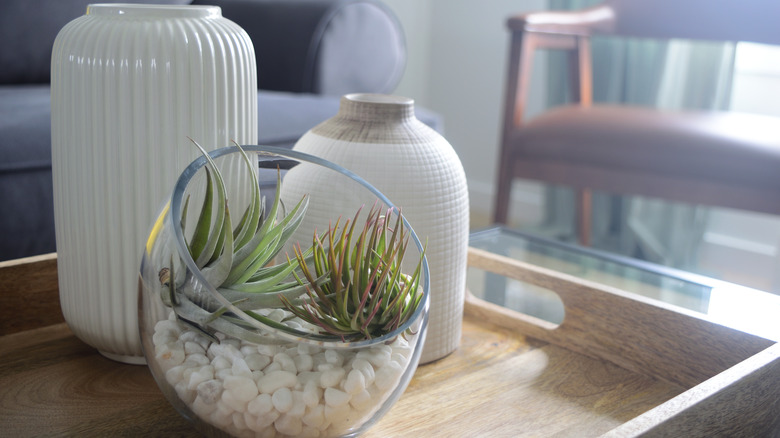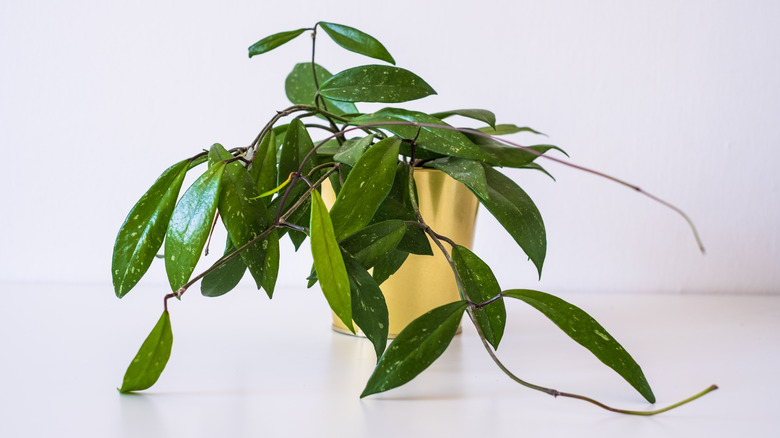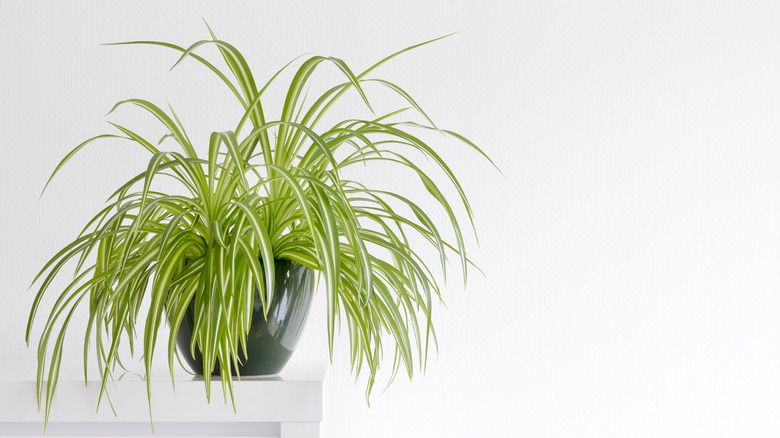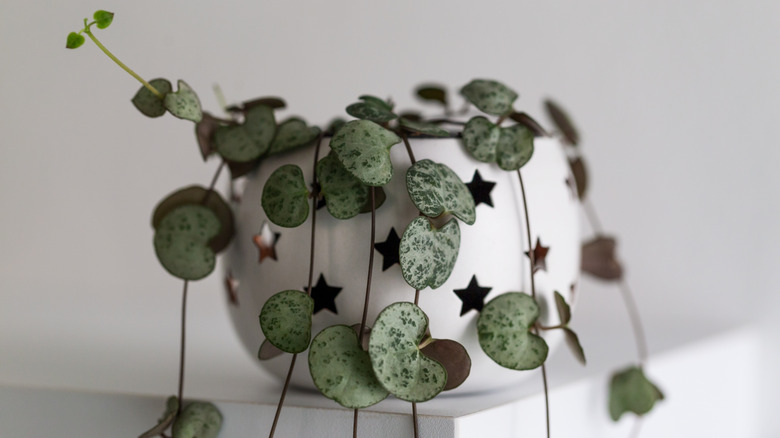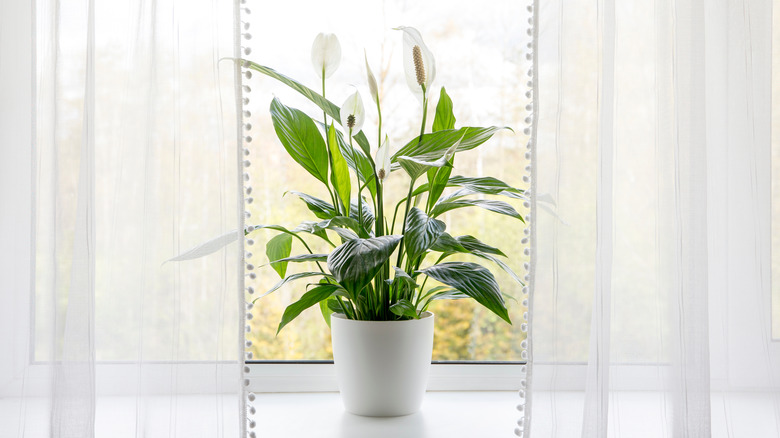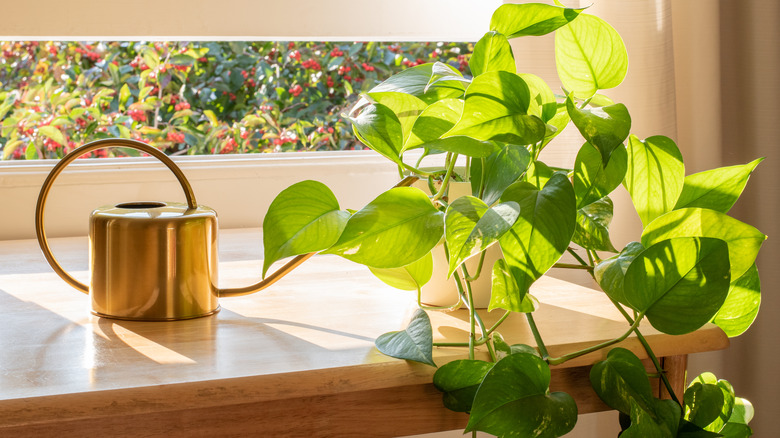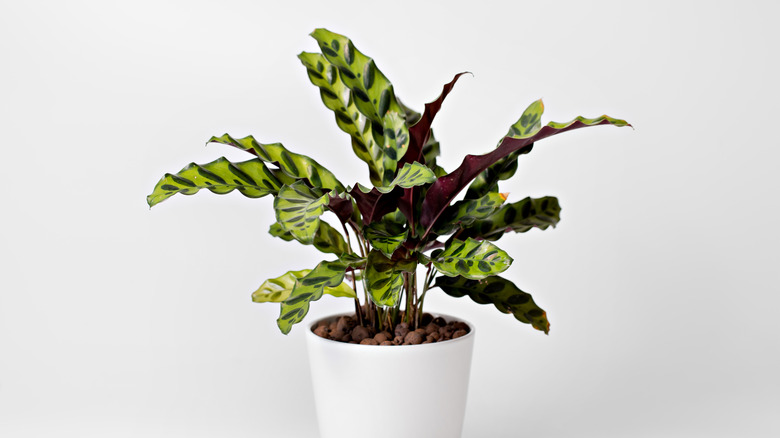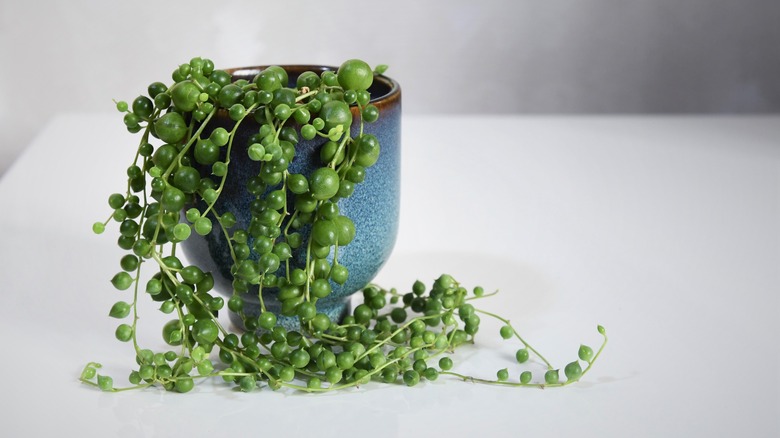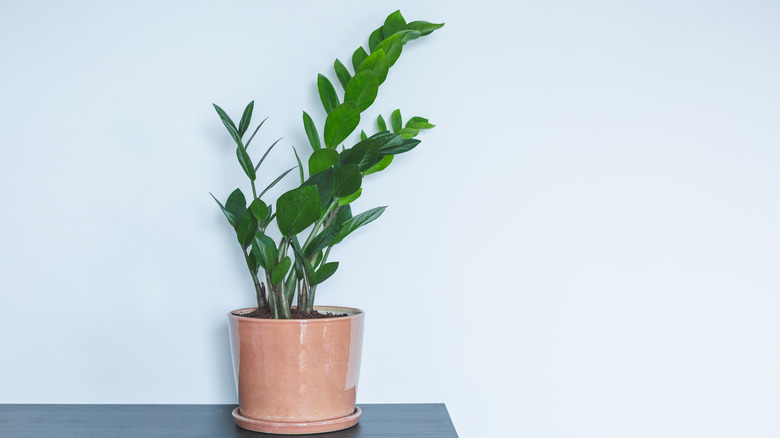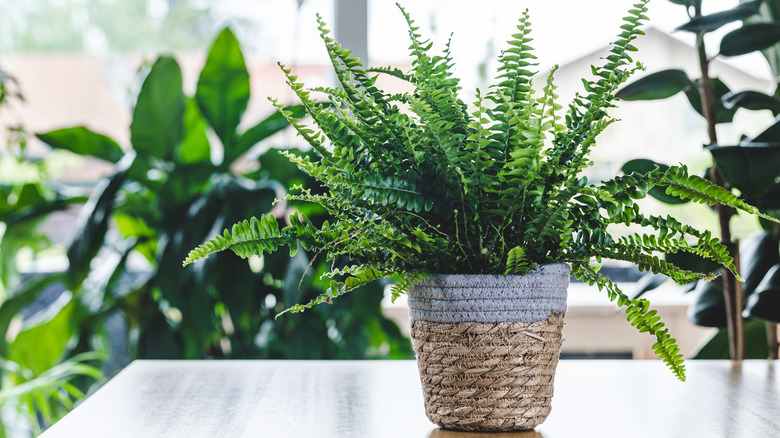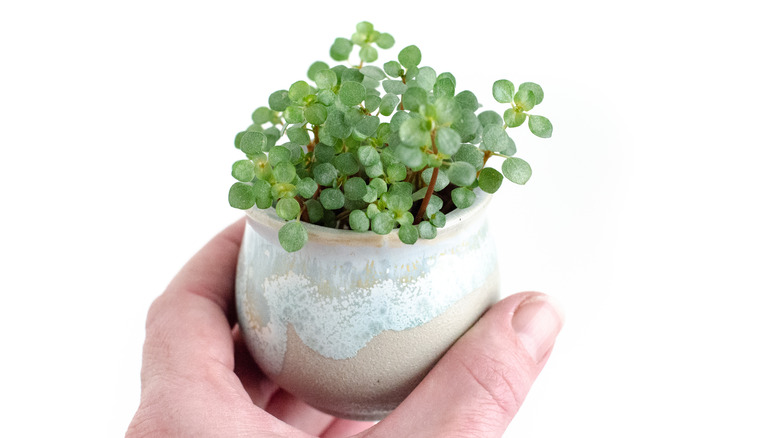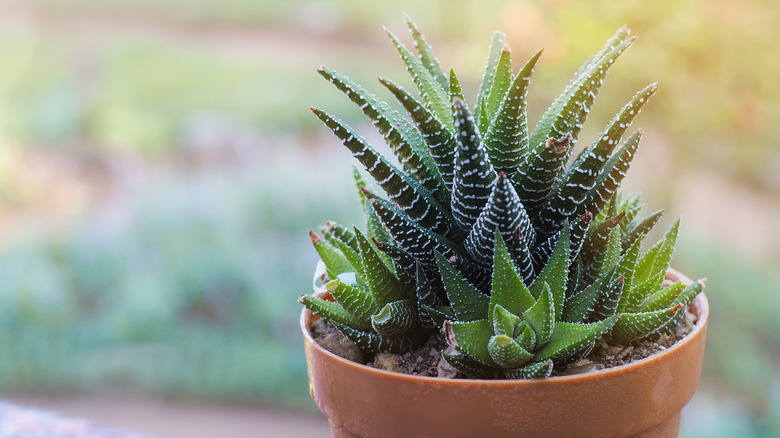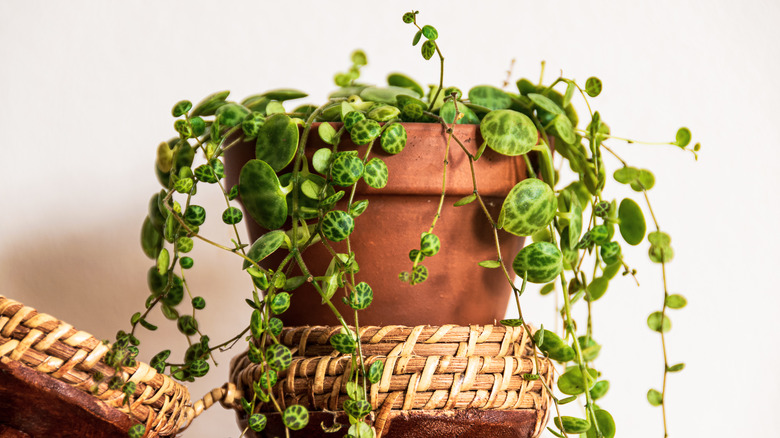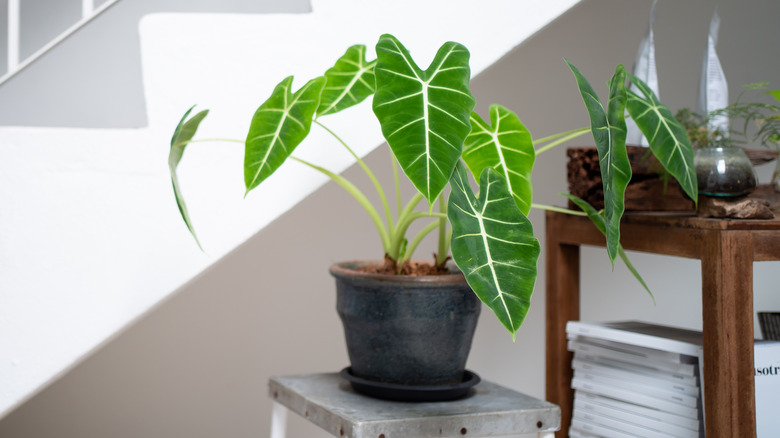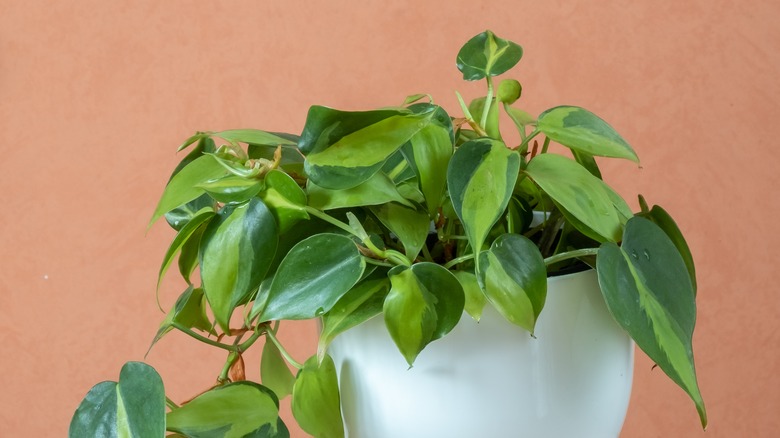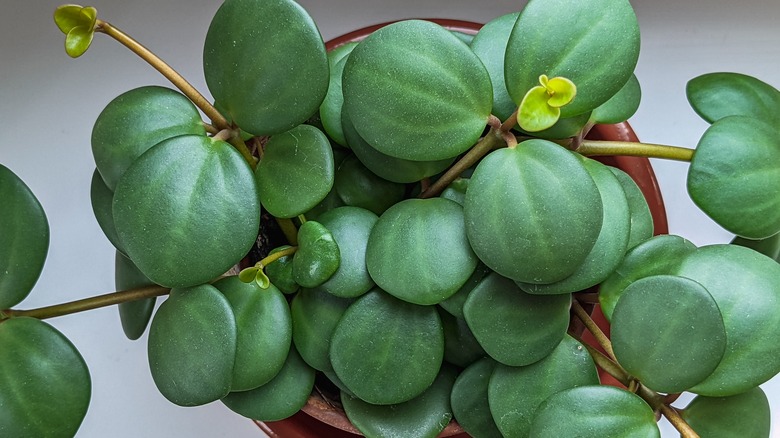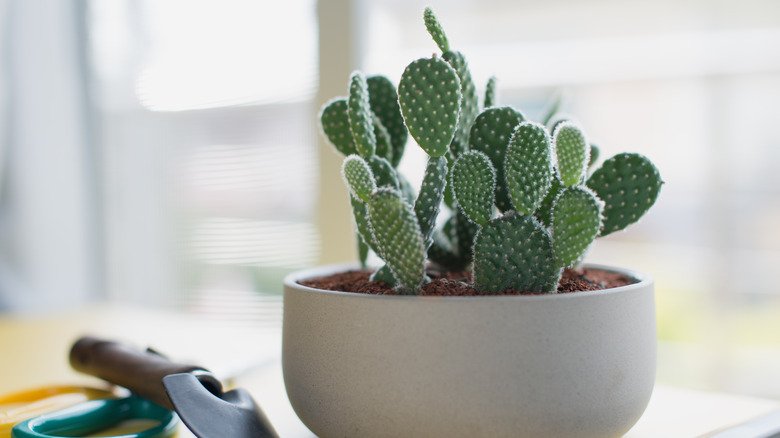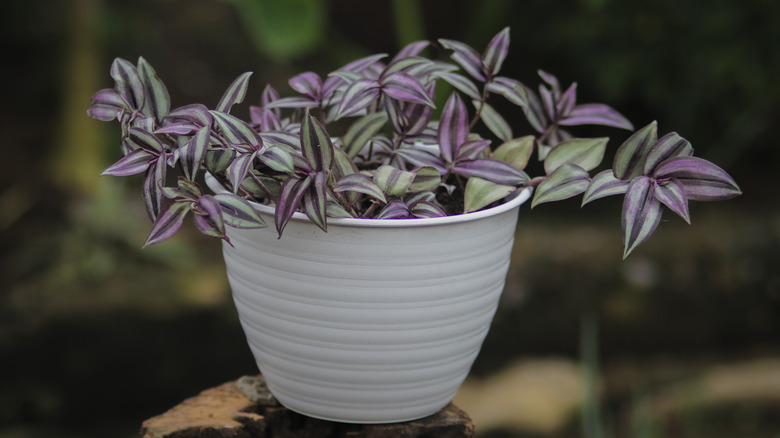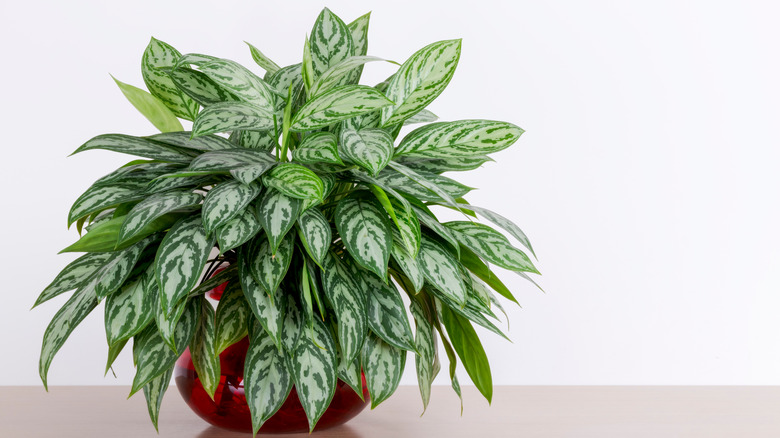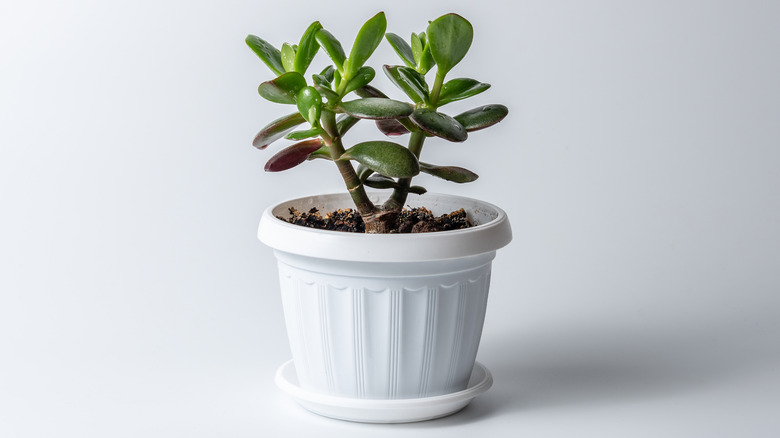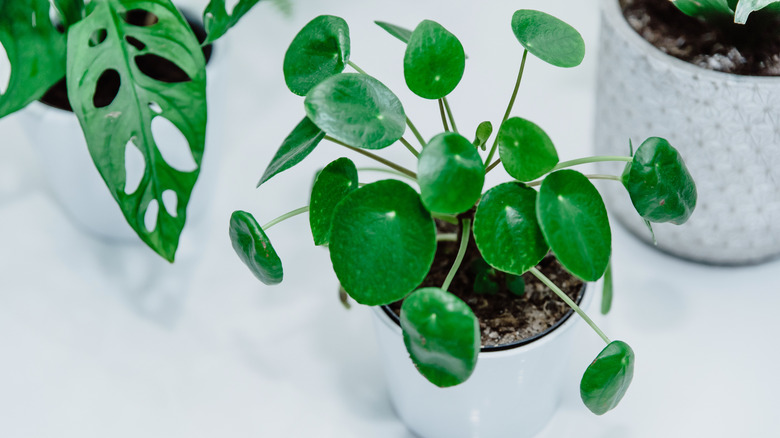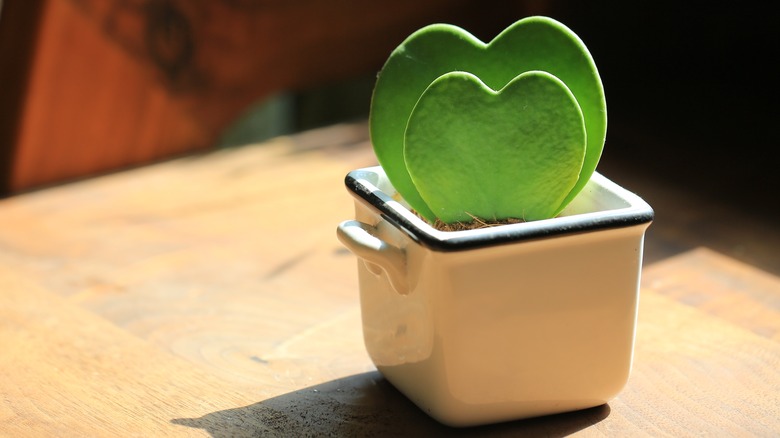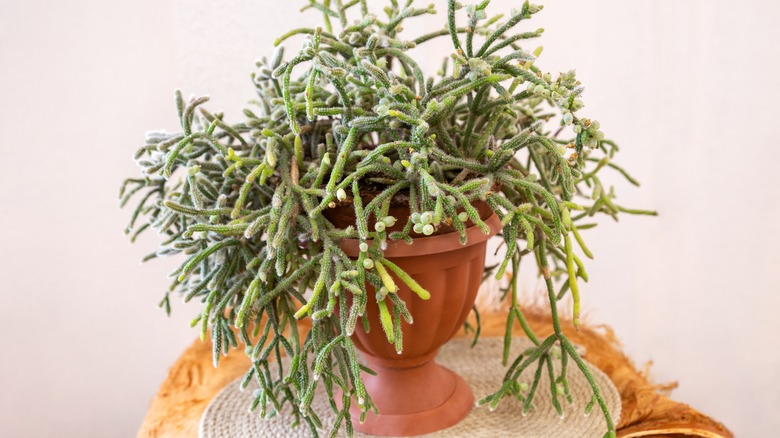25 Houseplants Perfect For Spaces On Your Bookshelf
Adding houseplants to your bookshelf is the perfect way to add style to your space. Not only are plants beautiful to look at, but they add warmth, texture, and dimension. There are many creative ways to decorate a bookshelf, with adding greenery very near the top of any list. While it's true that any plant can spruce up a shelf, you need to think about the plant itself and the care it'll need. Most importantly, you should choose houseplants that can live with the amount of light that reaches your bookcase.
Another part of decorating with plants is picking the perfect pot. Terracotta pots are timeless, but you can find eccentric ones from thrift stores or purchase a matching set. Then it's time to find a spot on the shelves. Larger plants will look good sitting beside the bookcase, and smaller ones can be tucked between books. If you don't have a lot of bookends, feel free to use a plant. Placing your pots on a saucer is vital, so you don't damage your books with water.
1. Nerve plant
Nerve plants (Fittonia albivenis) will stand out on your bookcase because of the pattern on their leaves. Unlike other houseplants, the veins on this plant resemble the nervous system or a lace pattern. There are many variations of this plant, including one with pink leaves and red veins. Nerve plants can tolerate low light, although they do best in bright, indirect light. Note that this is a sensitive plant, so you shouldn't give it any cold or tap water. Nerve plants will also dramatically droop their leaves if you forget to keep their soil moist.
2. Prayer plant
Prayer plants (Maranta leuconeura) have oval-shaped leaves with red veins that resemble a herringbone pattern. This plant is unique because the leaves close together and then open in the morning every night. This plant can live in low to bright, indirect lighting. It should be watered about once a week or more frequently if you provide a lot of light. The soil should never dry before you water it again.
3. Air plants
Air plants (Tillandsia) are unusual houseplants because they don't need soil to live. They naturally grow on trees but will call any item their home. Depending on how dry the air is in your house, you may need to water them more frequently than the average one to two weeks. To water them, fill a bowl with water and place the plant face down to soak for 10 to 20 minutes. Then shake any excess water from them and return them to their home. They also need bright, indirect light.
4. Hoya
Hoyas (Hoya carnosa) are a vining plant with waxy dark green leaves. They need bright, indirect light and water about every two weeks. Moving hoyas away from cold drafts and the dry air of heaters during the winter is vital to keep them alive and happy until spring. If you provide this plant with the perfect care, it will reward you with fragrant flowers. They bloom in clusters of pink or red flowers, similar to milkweed.
5. Spider plant
A spider plant (Chlorophytum comosum) is one of the easiest houseplants to own. Even if you forget to water it a few times, this plant won't drop all its leaves or die. Although, you should water it weekly. This plant can live with low to partial sun but prefers medium, indirect light. The better you care for a spider plant, the more pups it'll produce. Then you can propagate them as new plants for your collection or gift them.
6. String of hearts
String of hearts (Ceropegia woodii) are a cute vining plant. Not only are their leaves in the shape of hearts, but their variegation can be cream or pink. This plant is great for bookcases because if you put it at the top, the stems can grow up to 9 feet long, decorating each shelve with its foliage. Water your string of hearts weekly and place the plant by a south- or west-facing window. Aim to give it bright, indirect light if you aren't sure what type of window you have.
7. Peace Lily
Peace lilies (Spathiphyllum wallisii) have many different varieties and sizes, so you can pick one to best fit your bookshelf. If you fall in love with the large ones, you can also style them beside your bookcase. They're the perfect plant for a low-light library; in fact, peace lilies can even bloom while only getting two to four hours of light. They can also bloom their white flowers all year-round, with each lasting a month before it falls from the plant. To keep the soil from completely drying, you should water it weekly.
8. Golden pothos
If you're looking for a trailing plant to put on your bookcase and forget about, a pothos (Epipremnum aureum) is the one for you. Their vines can grow up to 10 feet long, and they thrive with some neglect. They prefer for their soil to dry out before you water them again. This will likely mean watering them every two weeks. Pothos also don't need much light, but they need bright, indirect light if you want their vines to grow super long.
9. Rattlesnake calathea
A rattlesnake calathea (Calathea lancifolia) has unique leaves with bent edges and are dark purple underneath. They will do best on a bookcase that is far from any windows. As a low-light plant that can handle up to medium light, an indicator that you're giving your plant too much sunlight is if the leaf pattern starts to disappear. A rattlesnake calathea should be watered weekly and more frequently during the growing season.
10. String of pearls
String of pearls (Senecio rowleyanus) is a succulent with fragile vines. On its stems, the foliage resembles green pearls, making it stand out on any bookcase. It's a quirky plant that will look cool trailing over your books. They need water about every two weeks. Since they like to be heavily watered, use a saucer to protect your books from the excess water running out of the drainage holes. String of pearls also needs bright, indirect sunlight. Anything more, and its foliage will burn; any less, and the stems will become leggy.
11. ZZ plant
ZZ plants (Zamioculcas zamiifolia) are one of the easiest houseplants to take care of. This plant can withstand low to bright, indirect light, but if you want it to grow quicker, provide it with more sun. ZZ plants are so easy to care for because they have rhizomes, big bulbs at the base of their stems that hold water. Depending on the amount of sun, they need water every two to six weeks.
12. Lemon button fern
Lemon button ferns (Nephrolepis cordifolia) are as easy to take care of as any fern. Their leaves look similar to most ferns, except the lemon button fern has thinner stems that shoot straight up. They'll look good on a bookcase near a window with medium to bright, indirect light. Although, they need to be away from air vents that will dry the foliage. You should water your fern at least once a week so the soil doesn't have a chance to dry completely.
13. Pilea glauca
Pilea glauca (Pilea libensis) is known for its tiny clusters of round leaves that almost appear to sparkle. To care for them, place them in an area with bright, indirect sunlight. Then make sure you keep the soil moist but not too wet. This is a tricky plant that is prone to root rot, so you should always check the soil before watering it.
14. Zebra plant
Zebra plants (Haworthia fasciata) are a special type of succulent because they don't need bright sun like this family of plants usually does. Instead, it lives happily in low to medium light. Zebra plants also stay relatively small, only reaching 8 inches tall at the most. They got their name from their dark green leaves with white bumps in a pattern that mimics a zebra's fur. Like other succulents, this plant needs the potting mix to dry out before another watering. Always check the soil before watering, about every two to three weeks.
15. String of turtles
String of turtles (Peperomia prostrata) is another fun-shaped plant. It is similar to string of hearts, except its leaves are round with variegated patterns that make them look like turtle shells. They need medium to bright, indirect light and like for the soil to dry out between waterings. You should be able to go two to three weeks before watering them again. A slow-growing plant, don't expect to see long stems on your string of turtles within the first few years.
16. Alocasia
Alocasias (Alocasia macrorrhizos) have many different names. Some common ones are elephant ears and prayer plants. Their large triangle-shaped leaves are one of the reasons for their nicknames. To care for them properly, they need a humid climate with lots of sun. Medium to bright, indirect light is best, as well as watering at least once a week. The soil should always be moist but not wet. This plant would benefit from a humidifier in the room or frequent misting.
17. Philodendron Brasil
Philodendron Brasil (Philodendron hederaceum) is also known as the heartleaf philodendron because of the shape of its foliage. It's a vining plant that will look beautiful, framing the shelves of your bookcase. Most philodendrons do well in low light, but if you want to keep the variegation in its leaves, you'll need to provide bright, indirect sun. You should also make sure not to let the soil dry completely. Watering your Philodendron Brasil once a week is best if you give it a lot of sunlight.
18. Peperomia hope
Peperomia hope (Peperomia tetraphylla) is another plant with round-shaped leaves. Except, these are thick and waxy. This peperomia is the best for putting on a bookcase because it has a shallow root system that allows it to fit in smaller pot. To care for this plant, you should water it every one to two weeks. It also needs bright, indirect light from an east- or west-facing window to grow properly.
19. Bunny ear cactus
The bunny ear cactus (Opuntia microdasys) is a cute plant that grows to look precisely how its name describes it. It's a miniature version of the prickly pear cactus, making it fit perfectly on a shelf surrounded by books. It needs direct sunlight and special cactus soil. You should let the dirt completely dry before watering it again, usually about every one to two months.
20. Inch plant
The inch plant (Tradescantia zebrina) is a vining plant with purple and green oval-shaped leaves. This species also has a silver shine on its foliage, while others have what feels like fur. It grows fast, is perfect for a beginner plant owner and would do well near a window that provides bright, indirect light. Watering this plant can be tricky, so make sure to check the soil once a week. If it is almost dry, you can water it.
21. Chinese evergreen
The Chinese evergreen (Aglaonema commutatum) is another slow-growing plant, but if you're patient for it to mature, it will reward you with flowers. The plant blooms in the summer, and then those flowers turn into berries. Chinese evergreens are great for a bookcase because they can live with low light. A tip to keep in mind is that the darker the leaves are, the less light the plant will need. Its soil must constantly be moist, so you should water it about once a week.
22. Jade
Jade plants (Crassula ovata) will add a nice touch to your bookcase because they're also known as the lucky plant. They're succulents that look cute as tiny seedlings but can grow up to 5 feet tall over many years. The best place to put them is near a south-facing window because they love bright sunlight. They should be watered about every two to three weeks or less if they aren't getting as much light to dry out the soil.
23. Chines money plant
Chinese money plants (Pilea Peperomioides) are distinct plants with glossy round-shaped leaves. They're notorious for growing pups in their pot. If you take good care of them, your entire bookcase can be full of young Chinese money plants. These plants do best in well-draining soil that has peat moss or perlite in it. Then you can water them weekly without worrying about root rot. Placing this plant near an east- or west-facing window will provide it with the proper amount of sunlight.
24. Sweetheart hoya
The sweetheart hoya (Hoya kerrii) is known for its distinct shape. Although, it's usually depicted as a single heart-shaped leaf in the pot, which is only a propagation of a mature plant. As it grows, this hoya has long vines covered in these lovely leaves. This hoya type needs full sun and well-draining soil. You can water it about every two to three weeks or when the potting mix is almost dry.
25. Mistletoe cactus
The mistletoe cactus (Rhipsalis baccifera) is a quirky plant that looks cute in fun pots. A fun way to style it is in a planter painted like a head so the cactus can grow like hair that hangs over the longer it gets. Caring for mistletoe cactus means providing it with water at least once a week and lots of humidity. Unlike most cacti, this type doesn't need a lot of sun, as it prefers low to medium light.
